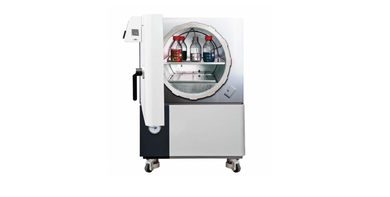Laboratory Autoclave Basics: Purpose, Types, Working Principle and More
The purpose of autoclaves
Autoclaves are commonly used pieces of laboratory, healthcare, or industrial equipment. The purpose of an autoclave is to thermally destroy microorganisms. These devices are used to sterilize and disinfect instruments, media, or biological waste. Autoclaves are essential when working in laboratories as they ensure that contamination is eradicated when using laboratory tools, or other materials.
The types of autoclaves
Autoclaves can look very different from each other – from small boxes found in places such as your local nail salon to huge pieces of equipment with double doors, more commonly found in industrial settings. But size and capacity are not the only differing factors when it comes to autoclaves. Another common way to categorize autoclaves is by their class. There are three classes:
- Class N – can be used for various objects (solids or porous material). These autoclaves are compact in size and are usually tabletop devices. Class N autoclaves usually reach a temperature of approximately 120-135℃. Because class N uses steam to push out the air, these autoclaves cannot guarantee 100% effectiveness.
- Class B – autoclaves use a vacuum pump to remove all of the air in the chamber. Because of this effective method, class B can offer the highest reliability available. The temperature of class B autoclaves usually reaches around 135℃.
- Class S – autoclaves fall in the middle between class B and class N in terms of performance. They have some advantages in comparison to class N. For example, they usually have a microprocessor, therefore are more reliable and precise. Contrary to class N autoclaves, class S has a drying mechanism, and thus instruments will not come out wet after sterilization. Although, class S has less performance capability than class B and is less suitable for complicated instruments.
Sterilization time of autoclaves
The time required for sterilization primarily depends on achieving and maintaining the appropriate temperature and pressure levels within the autoclave chamber. Autoclaves use high-pressure steam to kill microorganisms and achieve sterilization. The duration of the process allows for the steam to reach all areas of the load and effectively eliminate any potential contaminants.
The duration of the sterilization process in autoclaves can vary depending on several factors, including the type of items being sterilized, the load size, the autoclave's specifications, and the settings chosen. However, in general, autoclave sterilization cycles typically range from 15 to 60 minutes. Although, it's important to note that additional time is needed for the autoclave to reach the desired temperature and pressure levels before the cycle begins, and there is also a cooling-down period after the cycle is complete, which allows the items to be safely removed from the autoclave.
For precise information on the sterilization times, it is best to consult the specific autoclave's manufacturer guidelines or operating instructions, as different models may have varying cycle durations and settings.
Working principle of autoclaves
Autoclaves use moist heat for sterilizing objects. Autoclaves work on the principle of using high temperature and pressure to achieve effective sterilization. Items or substances to be sterilized are placed inside a sealed chamber, and water is added to generate steam. The autoclave is heated to a specific temperature, typically between 121 to 134 degrees Celsius, while the pressure inside the chamber increases. The combination of high temperature, steam, and pressure effectively kills microorganisms, including bacteria, viruses, fungi, and spores. After a specified sterilization time, the autoclave is cooled down, and the pressure is released.
There are a few differences in how autoclaves work between different classes (N, B, S). For example, in class N autoclaves – air removal is executed by displacing gravity and using steam to push out the air. Class B autoclaves use a vacuum pump for the removal of air and are very effective. Class S autoclaves remove the air inside the chamber using a steam wall which is denser than air.
Other methods of sterilization
Sterilization can be simply explained as destroying microorganisms such as bacteria, viruses, fungi, etc. It can be reached in any way that would create unsurvivable conditions for microorganisms. Autoclaves essentially utilize thermal disinfection, meaning that the temperature is raised enough to kill off microbes. This is one of the most effective ways but it takes some time to reach this temperature and not all objects can be fitted in an autoclave.
Chemical disinfection is another great way to sterilize various objects. It is usually cheaper to use chemicals and can be performed fast. This method is great for the disinfection of surfaces. Yet, there are some limitations to chemical sterilization as well – not all materials can take chemical disinfection and it also might be less effective in some cases.
For fragile objects and air disinfection, UV rays can be used. This method is not intrusive and less harmful to delicate objects. Some of the drawbacks of this method are that it is less effective (only a direct UV light path is effective for microorganism destruction). UV rays are also very harmful to people, therefore special carefulness is required while using UV for sterilization in greater capacities.
All in all, each sterilization method is useful when dealing with unwanted microorganisms. On each occasion, one might consider different ways of disinfection. Yet, autoclaves are one of the most popular and effective ways of taking care of medical instruments and laboratory tools.

